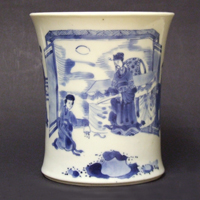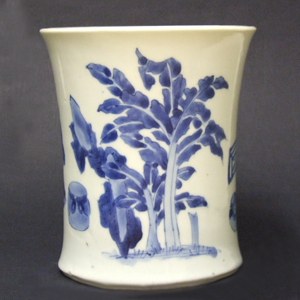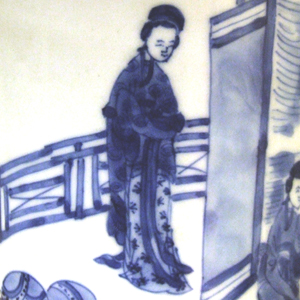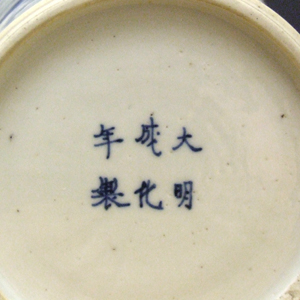
KANGXI 1662 – 1722. Chinese Taste Porcelain
A Fine Kangxi Blue and White Porcelain Brushpot Bitong c.1690-1700. Decorated with an Elegant Lady Holding a Bell Kneeling in Front a Scholar or Official who is Standing in Front of a Large Screen, an Assistant is Bringing him a Qin (click on the photograph for more information) wrapped in a fine cloth . The Other Side with a Large Banana Plant and a Further Lady who is Standing. The Base with an Apocryphal Six Character Chenghua Mark (Ming 1465-1487).
SOLD
- Condition
- Very good, a shallow chip to the footrim c.25 mm.
- Size
- Height : 12.8 cm (5 inches). Diameter : 11.3 cm (4 1/2 inches).
- Provenance
- N/A
- Stock number
- 21849
Information
Brushpots, Bitong :
Bitong, brushpots are not found in 17th or early 18th century European inventories unlike some other ceramic forms which fore fill a specific Chinese function. Blanc de chine `libation cups`, were for example, were made for drinking wine in China but they were imported in large numbers into the West. There curious forms appealed to Western tastes and were used in European displays or converted with the addition of a gilt bronze handle to become a bonbon dishes. Brushpots on the other hand seem to have been made exclusively for the Chinese domestic market, more specifically for the scholar literati class. Bitong are an essential part of literati`s desk, what is often referred to as a scholars desk. Other scholarly items for the desk might include a brush-rest, inkstone (for grinding the dry ink) a water pot for the water to add to the inkstone, a brushwasher as well as a table screen. As with the present brushpot the subject matter reflected scholarly themes.
Apocryphal Marks :
Apocryphal marks are frequently encountered on Chinese porcelain, particularly on Kangxi Blue and White Porcelain but also on Transitional porcelain like the present example. The mark of the Ming Emperor Chenghua who reigned from 1465 to 1487 being by far the most common, other Ming marks include Jiajing (1522-1566) and less frequently Wanli (1573-1620). These marks were not added to the piece to deceive, but more as a sign of reverence to earlier potters of the Ming dynasty (1368-1644). Occasionally they are used on pieces copying Ming Porcelain, these objects were probably made for collectors who could not afford the Ming original. Tianqi is an early period for such an apocryphal mark.
Qin, Guqin :
Guqin is the modern name for a plucked seven-string Chinese musical instrument of the zither family, which used to be referred to as a Qin. It has been played since ancient times, and has traditionally been favoured by scholars and literati as an instrument of great subtlety and refinement, as highlighted by the quote "a gentleman does not part with his qin or se without good reason," as well as being associated with the ancient Chinese philosopher Confucius. It is sometimes referred to by the Chinese as "the father of Chinese music" or "the instrument of the sages".
Traditionally the instrument was called simply qin but by the twentieth century the term had come to be applied to many other musical instruments as well: the yangqin hammered dulcimer, the huqin family of bowed string instruments, and the Western piano are examples of this usage. The prefix "gu-" (meaning "ancient") was later added for clarification. It can also be called qixianqin (lit. "seven-stringed instrument"). The guqin is not to be confused with the guzheng, another Chinese long zither also without frets, but with moveable bridges under each string. Because Robert Hans van Gulik`s famous book about the qin is called The Lore of the Chinese Lute, the guqin is sometimes inaccurately called a lute


